After having played around for a bit following my last post on Elite:Dangerous, I finally decided to “reset my commander” and start from scratch. And one of the things I wanted to show you today is how to explore a solar system you are new to and know nothing about. I have taken my ship to a system called LHS 3479 (not that it matters but that’s its name).
 My built-in Cartographics Database shows me a system made of three stars – for one of them, I already got information on some astronomical objects orbiting this sun.
My built-in Cartographics Database shows me a system made of three stars – for one of them, I already got information on some astronomical objects orbiting this sun.
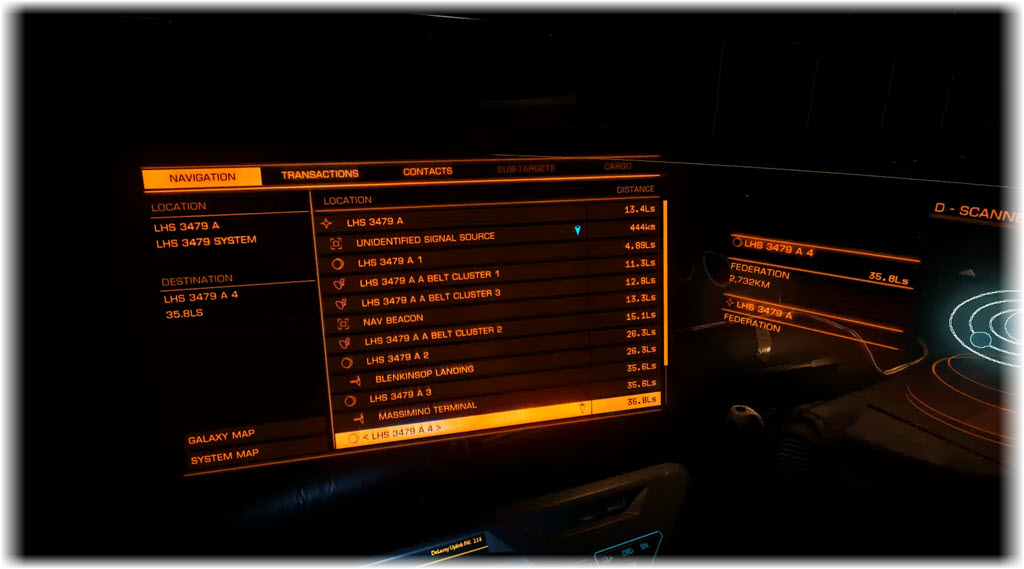 Now, keep in mind the notation: the system I am in is named LHS 3479. The first star (the one I am currently examining) has received the letter “A” as designator, so it is LHS 3479 A – the two other stars will be LHS 3479 B and LHS 3479 C.
Now, keep in mind the notation: the system I am in is named LHS 3479. The first star (the one I am currently examining) has received the letter “A” as designator, so it is LHS 3479 A – the two other stars will be LHS 3479 B and LHS 3479 C.
As I am currently really close to the star itself, the other objects appear “in sequence” – although in reality, their display is “by distance”. The first planet orbiting LHS 3479 A has received the designator “1” – it is LHS 3479 A 1. Now, I have already explored all astronomical objects in this solar system but I did not touch the two other stars yet – so my next target is LHS 3479 B.
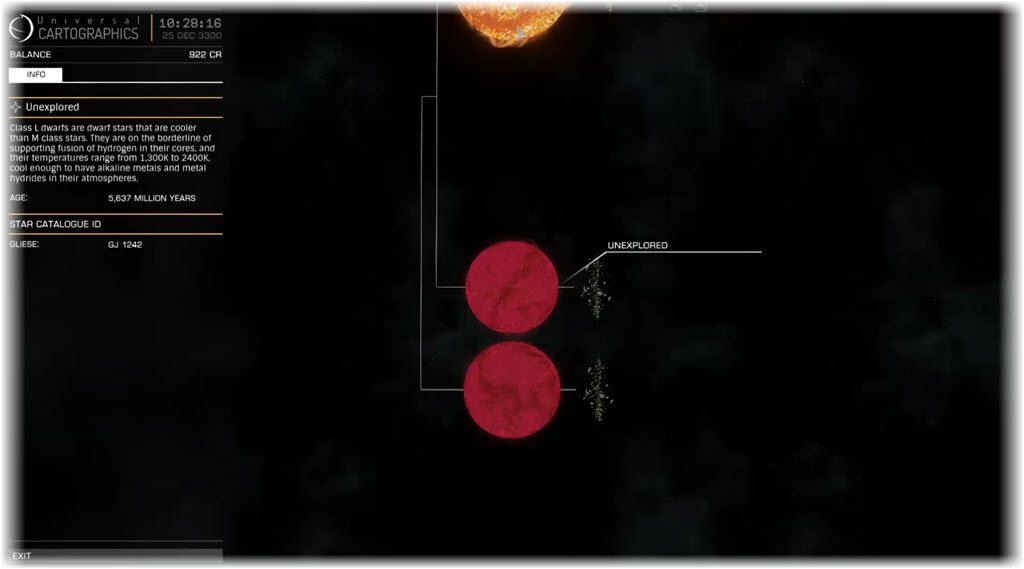 The image above shows: it is entirely unexplored (by me) – I know nothing about it… now, the good question is: how do we get there?
The image above shows: it is entirely unexplored (by me) – I know nothing about it… now, the good question is: how do we get there?
Size actually does matter!
Before I tell you a bit on how to find the next objects worth exploring, let’s take a look into the real universe, at our own Solar System. Why? Because Elite:Dangerous – like very few other games – is actually really close to some aspects of sciences. And understanding “the real thing” might help a bit in the game (plus: Astronomy is an interesting hobby to explore, too!).
First, let’s talk about our Sun: she is a quite “regular” star in our Milky Way, a so called “Class G” star. This actually touches what is called “Stellar Classification” and goes far beyond todays topic – but in a nutshell, a “Class G” Star is pure “mainstream” – not too big, not too small, not too hot, not too cold.
There are other classes – a “Class O” star, for example, marks the one extreme on the classification: is is a giant star, huge, super hot and bright. A prime example of this type of star is Alnitak in Orion. It is a triple-star system (just like the one in Elite:Dangerous shown above) with the main component, Alnitak Aa being a a super-giant star, almost thirty times the mass of the sun. It is 19 times larger in radius than our own Sun and about 180.000 times more luminous. It is “one hell of a star” – you’d get yourself a sunburn really quickly 😉
By the way: Alnitak Aa is named this way because it is itself a double star system (with Alnitak Ab being the second component). The double-star system is itself a component of a binary system with Alnitak B being the other (third) star in the game. Now take a look back up at how the stars are named in Elite:Dangerous: we got LHS 3479 A, B, and C which tells us (if all is properly named) that the three stars are forming one system without two of them making up a double-component.
Back to the stellar classification – if “Class O” are the super-giant stars, the other extreme are the “Class Y” stars: the Brown Dwarf stars. They are small (about a couple of Jupiter masses) and cold. They are strange worlds with no or almost no light.
And then, of course, we need to talk distances. Elite:Dangerous uses Light Years on the galactic distances and Light Seconds once you have entered a solar system. Both are true astronomical units. The Light Second is easy: it is the distance the light can travel in one second and we know that this is (roughly!) 300.000 km or 186.000 miles.
In our own Solar system, Neptune is the planet farthest from the sun. It is roughly 30 times farther from the Sun than our own Earth is. So let’s do some math:
- The distance between the Sun and the Earth is roughly 150.000.000 km. Which means that light “leaving” the Sun needs about 500 seconds (at 300.000 km/s) to reach Earth. A bit over 8 Minutes. Or – in other words – the Earth is 500 Light-Seconds away from the Sun.
- Neptune is an unbelievable 30 times farther out – roughly 4.500.000.000 km. Light “leaving” the sun needs 15.000 seconds (or a bit over 4 hours) to reach the planet. So we can say: Neptune is 15.000 Light-Seconds from Sun.
So our Elite:Dangerous solar system LHS 3479 is significantly more packed than our own Solar System. But hey, that is game-play – and you will see in a moment, why.
How do we get to LHS 3479 B?
Leaving the real universe behind: how do we find LHS 3479 B? At least in the beginning, we cannot rely on our built-in ship scanner – it is of minor quality and will only find astronomical objects within about 400 – 500 Light-Seconds (Ls). That’ll do for some planets but not other stars.
I basically found three ways of isolating directions to fly to for further exploration:
- If there are other ships around, you can see their trail very well and you can just try to follow them.
- Even if you have lost the visual contact to another ship, it will leave a signature when leaving hyperspace: a Frameshift-Drive Wake (FSD Wake). These are discoverable by targeting them (and that will work beyond 500 Ls).
- Apply practical Parallax observation. Elite:Dangerous features a 3D-Universe and this does work – I will show you later.
Bot for now, let’s focus on FSD-Wakes first.
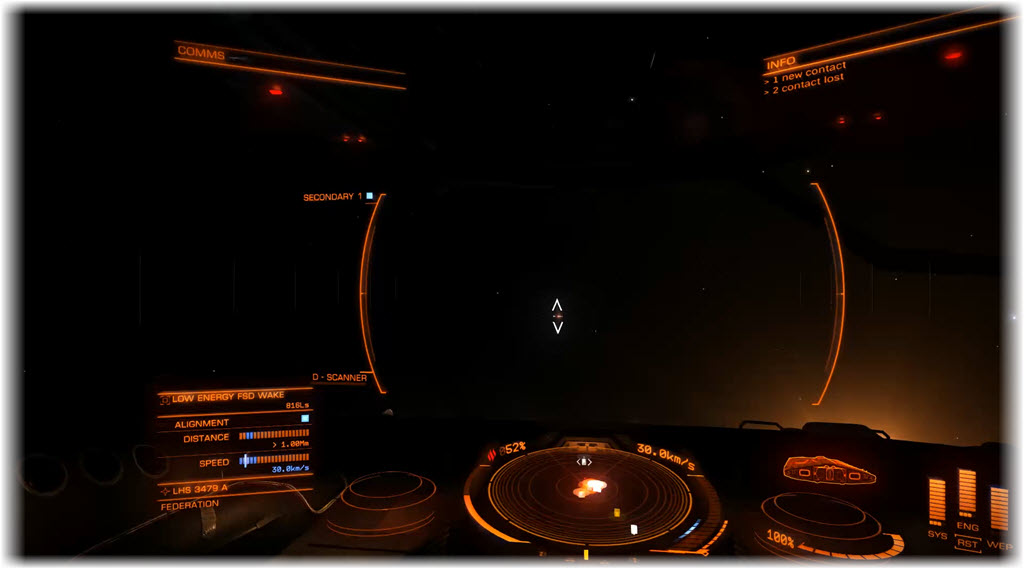 The image above shows a targeted FSD-Wake in about 800 Ls distance. This is (currently) beyond the range of my basic discovery scanner so the thing to do is throttle up and head into the general direction of the FSD-Wake signature. When coming closer, I use the discovery scanner again, this time within its range limits.
The image above shows a targeted FSD-Wake in about 800 Ls distance. This is (currently) beyond the range of my basic discovery scanner so the thing to do is throttle up and head into the general direction of the FSD-Wake signature. When coming closer, I use the discovery scanner again, this time within its range limits.
 The result: 12 new Astronomical Objects discovered. Now, there is no “up” or “down” in space but by coincidence, I was approaching the discovered system right “from the side”. In order to see another interesting feature in Elite:Dangerous, I had to get out of the orbital plane of the planets.
The result: 12 new Astronomical Objects discovered. Now, there is no “up” or “down” in space but by coincidence, I was approaching the discovered system right “from the side”. In order to see another interesting feature in Elite:Dangerous, I had to get out of the orbital plane of the planets.
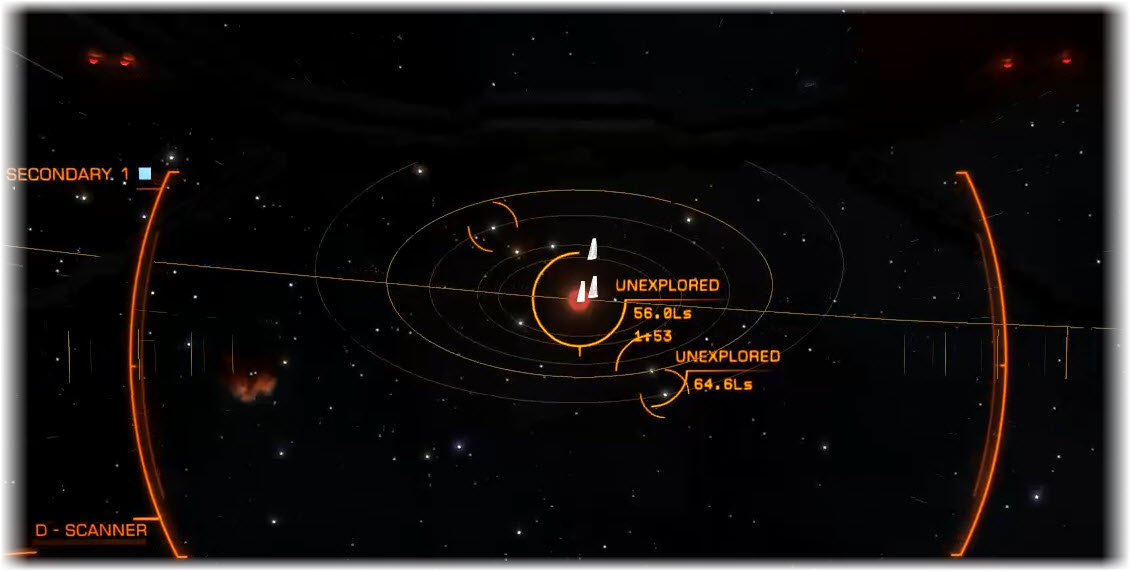 Depending on the view angle, you can see the orbits of elements around its center body – that is the orbits of planets around a star or (when further in) the orbits of moons around a planet. The image above shows five planets orbiting the star and an almost straight line representing the star’s orbit around the center of gravity of the triple-star system (which we will see later).
Depending on the view angle, you can see the orbits of elements around its center body – that is the orbits of planets around a star or (when further in) the orbits of moons around a planet. The image above shows five planets orbiting the star and an almost straight line representing the star’s orbit around the center of gravity of the triple-star system (which we will see later).
Now you need to scan the unexplored items – and that works automatically but depends on the size of the object and your distance from it. Target the object, then move in. Scanning will start automatically. For stars, they can be scanned from about 100 Ls, Planets from within this range.
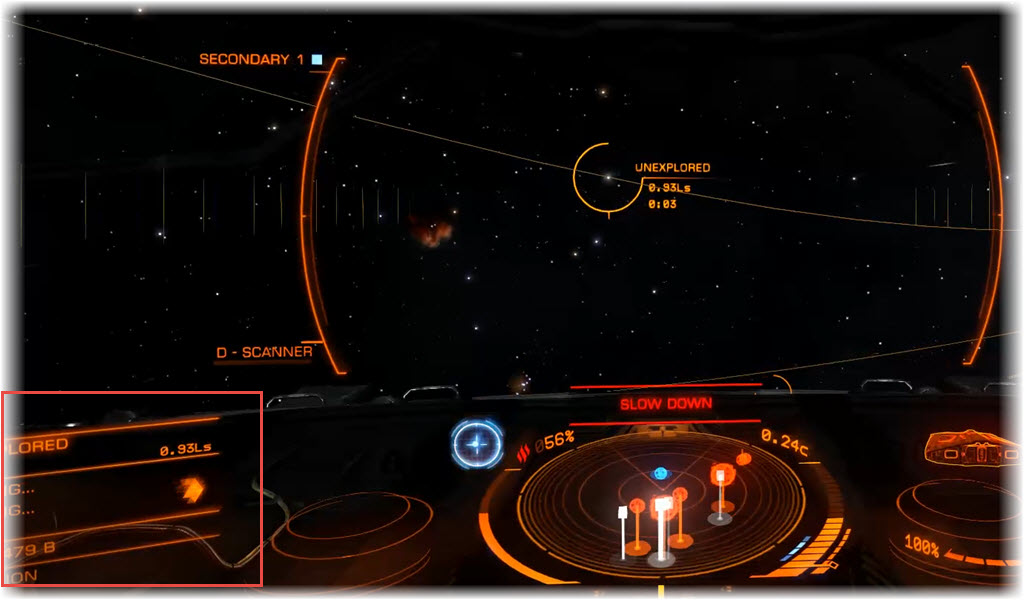 See the red frame in the lower left corner? This is where the scanning and eventually the scanned results are shown. All you need to do is target the unexplored… which is only a bit of work once you discovered them.
See the red frame in the lower left corner? This is where the scanning and eventually the scanned results are shown. All you need to do is target the unexplored… which is only a bit of work once you discovered them.
Now, in my solar system, with two stars discovered and their planets scanned, I am heading out to find the thirds star. Which proofs to be a but tricky… first of all, I really need to “leave” the two solar systems – here is a look back from about 2.300 Ls out (and we already know that the dimensions in Elite:Dangerous are smaller than in the real universe).
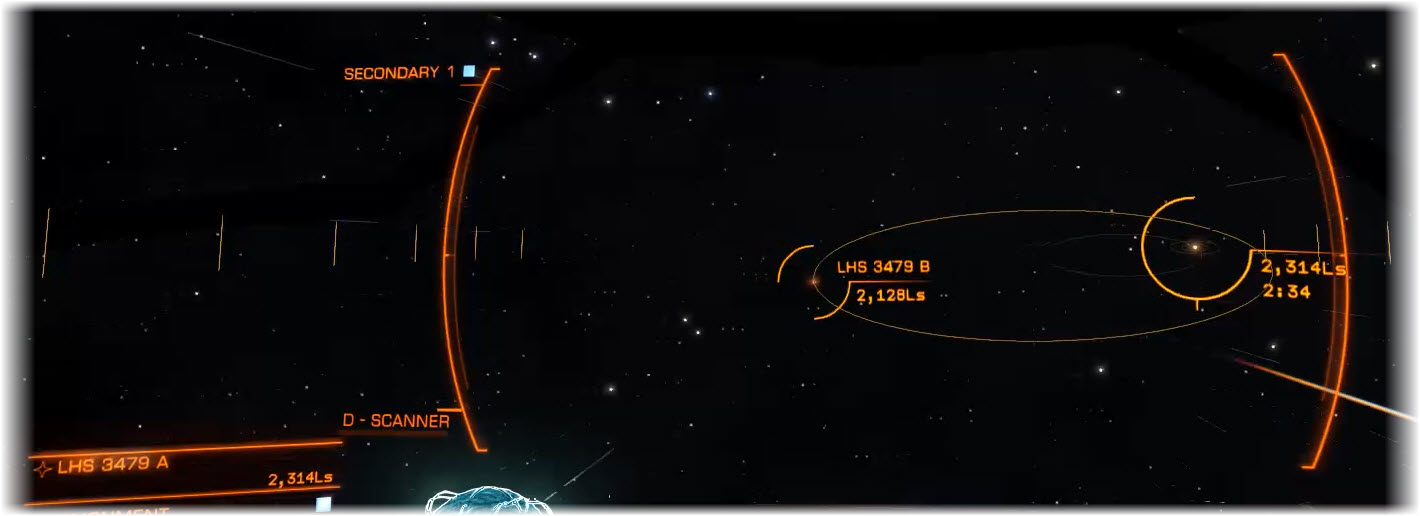 The image above neatly shows LHS 3479 A (selected, on the right) and LHS 3479 B with their respective stellar orbits. On my way out, I found another FSD-Wake signature (as described above) and then scanned the area with the basic discovery scanner. This is what I found:
The image above neatly shows LHS 3479 A (selected, on the right) and LHS 3479 B with their respective stellar orbits. On my way out, I found another FSD-Wake signature (as described above) and then scanned the area with the basic discovery scanner. This is what I found:
 Not the expected third star but a giant gas planet, orbiting not one of the known stars with both – designator LHS 3479 AB 1. Plus five moons, classified as “ice planets”. Eventually, it turned out that there was a second gas giant out there: LHS 3479 AB 2.
Not the expected third star but a giant gas planet, orbiting not one of the known stars with both – designator LHS 3479 AB 1. Plus five moons, classified as “ice planets”. Eventually, it turned out that there was a second gas giant out there: LHS 3479 AB 2.
Finally, I found my last missing star – again, a FSD-Wake helped but this time, I wanted to show you the parallax approach.
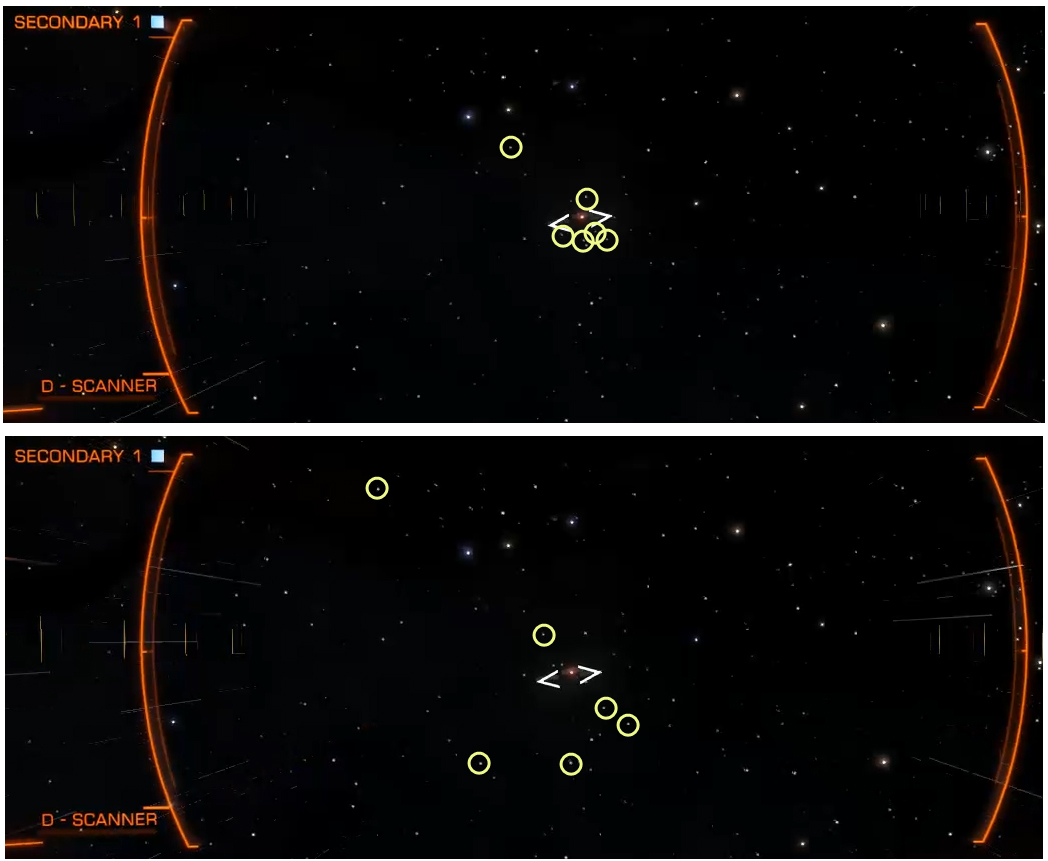 The two images above show my view of the space while approaching the third solar system. Between them lies possibly 60 seconds of flight. The top one is the first one – the objects marked are actually planets, the third star is the red “dot” in the center.
The two images above show my view of the space while approaching the third solar system. Between them lies possibly 60 seconds of flight. The top one is the first one – the objects marked are actually planets, the third star is the red “dot” in the center.
Between the first and the second image, some objects that could have been perceived as background stars actually moved – that is because they are much closer than the stars in the distance and as I changed my position, they also changed their relative positions compared to the (unmoving) background.
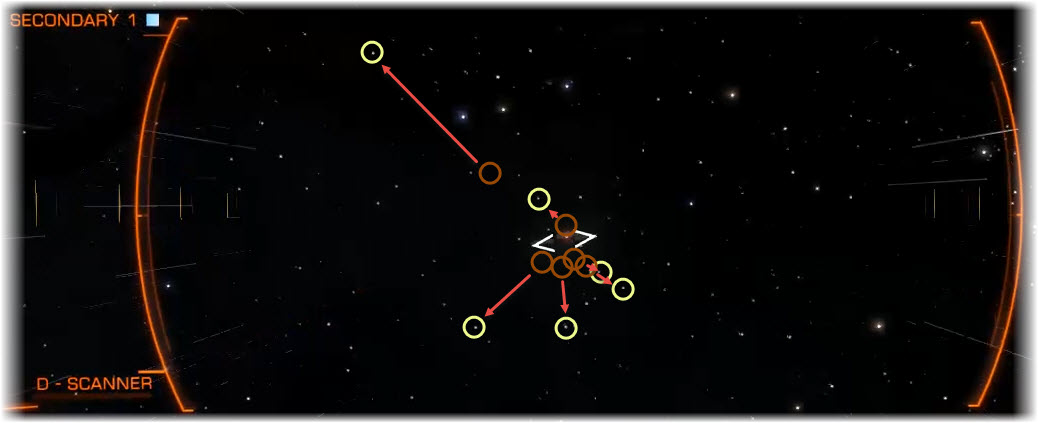 In-game, the effect is much more obvious as you can see the “dots” moving across the background once you found out what to look for. Finally, I had found the third star with its orbiting planets.
In-game, the effect is much more obvious as you can see the “dots” moving across the background once you found out what to look for. Finally, I had found the third star with its orbiting planets.
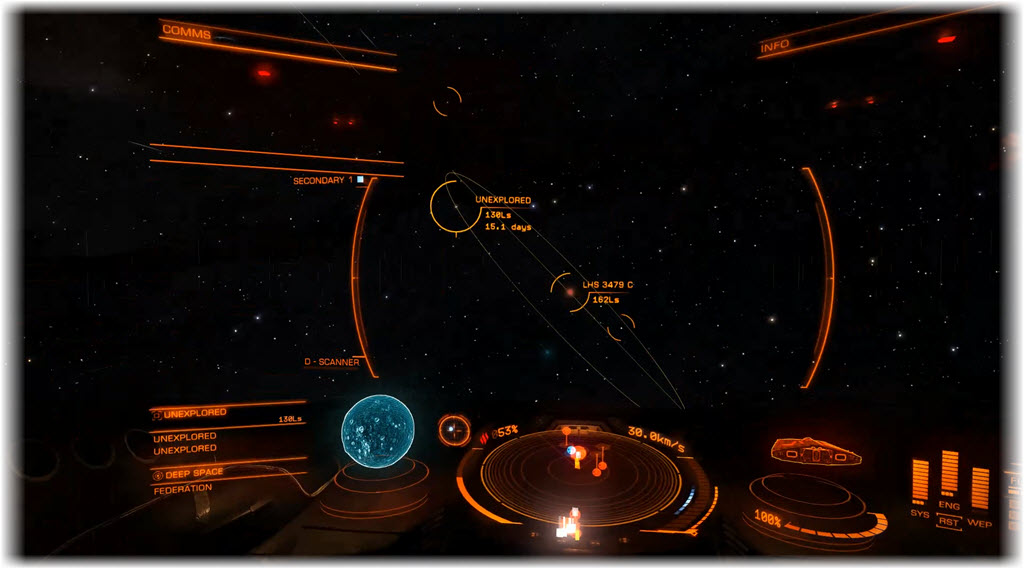 Now, with the entire system scanned, I headed of to a different star system to dock at McNair Gateway Station. And since money is always (and with Elite always was!) a concern, I am delighted to see that my work can be sold for roughly 19.000 Credits once I reach a system that is more than 20 Light-years away from the scanned system.
Now, with the entire system scanned, I headed of to a different star system to dock at McNair Gateway Station. And since money is always (and with Elite always was!) a concern, I am delighted to see that my work can be sold for roughly 19.000 Credits once I reach a system that is more than 20 Light-years away from the scanned system.
 Nice to see that there is an “exploratory way” to earn money…
Nice to see that there is an “exploratory way” to earn money…
